Roadmap for Answer Writing 1. Introduction Define organic and natural farming. Organic farming involves using natural inputs and processes to enhance soil health, biodiversity, and overall environmental sustainability. Natural farming, a more traditional practice, relies heavily on mimicking natural ecosystems with minimal human intervention. Key ...
- Recent Questions
- Most Answered
- Answers
- No Answers
- Most Visited
- Most Voted
- Random
- Bump Question
- New Questions
- Sticky Questions
- Polls
- Followed Questions
- Favorite Questions
- Recent Questions With Time
- Most Answered With Time
- Answers With Time
- No Answers With Time
- Most Visited With Time
- Most Voted With Time
- Random With Time
- Bump Question With Time
- New Questions With Time
- Sticky Questions With Time
- Polls With Time
- Followed Questions With Time
- Favorite Questions With Time
Mains Answer Writing Latest Questions
List the problems that India has with managing and storing food grains. Mention the actions the government has done to resolve this as well.
Roadmap for Answer Writing To effectively answer the question regarding the role of millets in ensuring health and nutritional security in India, follow this structured approach: Introduction Define millets and their significance in the agricultural landscape of India. Mention the recognition of millets by ...
-
Model Answer Introduction Millets, recognized by the United Nations as the International Year of Millets in 2023, are vital for enhancing health and nutritional security in India. These ancient grains are not only nutritious but also resilient to climate change, making them a sustainable choice forRead more
Model Answer
Introduction
Millets, recognized by the United Nations as the International Year of Millets in 2023, are vital for enhancing health and nutritional security in India. These ancient grains are not only nutritious but also resilient to climate change, making them a sustainable choice for the future.
Health Security
- Antioxidant-Rich Composition: Millets are rich in antioxidants, which help reduce oxidative stress and prevent chronic diseases. For example, ragi is known for its high antioxidant content, supporting cellular health.
- Gluten-Free Alternative: Naturally gluten-free, millets like jowar are suitable for individuals with celiac disease or gluten intolerance, allowing broader dietary options.
- High Fibre Content: Millets, such as bajra, are rich in dietary fibre, promoting digestion and gut health while preventing constipation.
- Stabilizing Blood Sugar Levels: With a low glycemic index, millets help regulate blood sugar levels, making them particularly beneficial for diabetes management.
- Cardiovascular Benefits: Millets can lower cholesterol levels, improving heart health. Pearl millet, for instance, is associated with reducing bad cholesterol.
Nutritional Security
- Protein-Rich Source: Millets provide a good source of plant-based protein, essential for muscle development and overall body function.
- Vitamins and Minerals: Packed with vitamins (like B-complex) and minerals (such as magnesium and iron), millets contribute significantly to overall health. Bajra is particularly rich in magnesium, supporting bone health.
- Combating Anaemia: Rich in iron, millets effectively combat iron-deficiency anaemia, especially among women and children.
- Micronutrient Rich: Millets contain vital micronutrients; for example, pearl millet is abundant in iron and zinc, crucial for immune function.
- Sustained Energy Levels: Millets provide slow-releasing carbohydrates, ensuring steady energy throughout the day. Foxtail millet, in particular, helps maintain energy levels without crashes.
Conclusion
Millets are essential for ensuring both health and nutritional security in India. Their adaptability and resilience make them a cornerstone for sustainable agricultural practices, contributing to food security while empowering farmers. Through increased awareness and supportive policies, millets can play a transformative role in the nation’s nutritional landscape.
Relevant Facts
- The United Nations declared 2023 as the International Year of Millets to promote their cultivation and consumption.
- Ragi is rich in antioxidants, which help combat chronic disease.
- Jowar serves as a widely accepted gluten-free grain in India.
- Pearl millet has been shown to reduce bad cholesterol levels, thereby improving heart health.
- Millets like bajra are significant sources of magnesium, aiding in various bodily functions.
By promoting the cultivation and consumption of millets, India can enhance health outcomes and nutritional security for its population.
See less
Roadmap for Answer Writing Introduction Contextualize the importance of millets: Mention the benefits of millets, including their nutritional value (high in fiber, minerals, and beneficial for managing diabetes and obesity), climate resilience, and ability to grow in water-scarce conditions. Link to the problem: ...
-
Best Answer
Model Answer Despite their numerous benefits, such as being nutritionally rich and climate-resilient, millets have seen a decline in adoption by Indian farmers. Several factors contribute to this low uptake: 1. Low Demand and Consumption Millets were once a staple in Indian diets but their consumptiRead more
Model Answer
Despite their numerous benefits, such as being nutritionally rich and climate-resilient, millets have seen a decline in adoption by Indian farmers. Several factors contribute to this low uptake:
1. Low Demand and Consumption
Millets were once a staple in Indian diets but their consumption has sharply declined. The per capita consumption fell from 32.9 kg in 1962 to just 3.87 kg in 2022. Factors contributing to this include the longer cooking time required for millets compared to rice and wheat, a lack of value-added millet-based products, and diminishing traditional knowledge of millet-based recipes.
These factors have led to reduced consumer interest and demand for millet Productivity and Marginal Land Cultivation Millet productivity averages only 1 to 1.5 tonnes per hectare, which is significantly lower than that of rice and wheat. This low yield results in reduced profitability for farmers, forcing them to grow millets on marginal lands with even lower productivity potential. Consequently, farmers are often discouraged from choosing millets over more profitable crops .
2. Government Procurement
The government’s procurement of millets remains insufficient, which further exacerbates the issue. For example, the procurement rates for pearl millet, sorghum, and finger millet are extremely low, ranging from 1% to 15% of their total production. In contrast, procurement for staple crops like rice and wheat is much higher, ensuring better prices and stability for these crops .
3. Poor Seed Storage Issues
Farmers often face challenges with low-quality seeds, which are either contaminated with weeds or diseases, reducing the chances of a good yield. Additionally, millets have a shorter shelf life and are prone to pest infestation during storage, leading to higher wastage and decreased profitability .
Conclusion
To boost millet cultivation, India needs to focus on improving seed quality, enhancing government procurement, providing better storage solutions, and developing modern processing technologies. These efforts can drive both production and consumption, enabling millets to regain their role in India’s agricultural landscape.
See less
List the several obstacles that India’s cattle industry faces. Additionally, recommend actions to get rid of these obstacles.(Answer in 200 words)
Roadmap for Answer Writing Introduction Begin with a brief context of the vulnerability of Indian agriculture. Mention factors like dependency on monsoon, extreme weather conditions, and the ...
-
Model Answer Introduction Indian agriculture is excessively dependent on monsoons, with only 35% of the total area under cultivation being irrigated as of 2010, according to the World Bank. This heavy reliance on monsoon rains, coupled with fluctuations and natural calamities such as droughts, floodRead more
Model Answer
Introduction
Indian agriculture is excessively dependent on monsoons, with only 35% of the total area under cultivation being irrigated as of 2010, according to the World Bank. This heavy reliance on monsoon rains, coupled with fluctuations and natural calamities such as droughts, floods, and hailstorms, has severely impacted farmers’ livelihoods. Even in years of abundant production, farmers often face price volatility, making crop insurance essential for stabilizing their income and production.
Need for Crop Insurance
- Protection Against Crop Failure: Crop insurance safeguards farmers from losses due to crop failures, ensuring stability in their income.
- Yield Protection: It provides coverage against reduced production and post-harvest losses, helping farmers recover from adverse conditions.
- Revenue Protection: The insurance offers a safety net against price fluctuations, guaranteeing a minimum assured income during bumper harvests when prices may crash.
- Reduced Government Expenditure: By minimizing the need for reactive relief measures during natural calamities, crop insurance serves as a proactive financial tool.
- Encouragement of Investment: With reduced risk, farmers are more likely to invest in innovative agricultural practices, enhancing productivity.
Recognizing these needs, the government introduced the Pradhan Mantri Fasal Bima Yojana (PMFBY) to replace the outdated National Agriculture Insurance Scheme (NAIS) and Modified National Agricultural Insurance Scheme (MNIAS), aiming to cover 47% of farmers within a year.
Salient Features of PMFBY
- Comprehensive Coverage: PMFBY covers Rabi, Kharif, and horticultural crops, including protection against various natural calamities and post-harvest losses.
- Affordable Premium Rates: The scheme offers a uniform premium rate of 2% for Kharif crops, 1.5% for Rabi crops, and 5% for commercial and horticultural crops, with the government subsidizing the remaining amount.
- Technological Integration: The use of remote sensing, smartphones, and drones facilitates quick assessment of crop losses.
- Area Approach Implementation: The scheme is executed on an area basis, focusing on homogenous crop cultivation and risk assessment at the village level.
- Optional Enrollment: Since 2020, enrollment in the scheme has been made optional for all farmers, moving away from the previous mandatory requirement for loanee farmers.
Conclusion
The increasing frequency of climate-induced extreme weather events and market fluctuations has heightened the distress among farmers, underscoring the urgent need for effective crop insurance. The PMFBY represents a significant step towards safeguarding farmers’ interests and promoting sustainable agricultural practices in India.
See less
Roadmap for Answer Writing 1. Introduction Start by defining millets as a group of nutrient-dense, drought-resistant grains. Mention the current status of millet cultivation in India, including its decline in recent years. Reference the UN’s declaration of 2023 as the International Year of Millets, ...
-
Best Answer
Model Answer Introduction Millets, once considered a "coarse" grain, are now being recognized for their exceptional nutritional value and environmental benefits. The United Nations General Assembly declared 2023 as the International Year of Millets, largely due to India’s advocacy. However, despiteRead more
Model Answer
Introduction
Millets, once considered a “coarse” grain, are now being recognized for their exceptional nutritional value and environmental benefits. The United Nations General Assembly declared 2023 as the International Year of Millets, largely due to India’s advocacy. However, despite their potential, the area under millet cultivation in India is declining. This answer explores the economic, social, and environmental advantages of expanding millet cultivation, the factors limiting its adoption, and the measures needed to address these challenges.
Economic Benefits
- Diversified Income:
Millets provide an additional source of income for farmers, reducing dependence on single crops like rice and wheat. This diversification can help stabilize income, especially for small-scale farmers. - Lower Input Costs:
Millets are hardy and require less water, fertilizers, and pesticides, making them cheaper to grow. This leads to lower production costs and higher profitability, especially for farmers in water-scarce regions. - Price Stability:
Millets are less vulnerable to price fluctuations than other major crops. This provides farmers with more stable returns and shields them from the volatility in rice and wheat markets.
Social Benefits
- Nutritional Security:
Millets are rich in dietary fiber, micronutrients, and antioxidants. They help combat malnutrition and improve dietary diversity, particularly among vulnerable populations like children and pregnant women. - Preservation of Traditional Knowledge:
By promoting millet cultivation, we help preserve traditional farming practices, which are integral to rural identities and cultural heritage. It fosters community ties and a sense of pride in local agricultural practices.
Environmental Benefits
- Water Efficiency:
Millets are drought-resistant crops that require significantly less water than rice and wheat. This makes them ideal for cultivation in water-scarce areas and helps conserve water resources. - Biodiversity:
Growing millets promotes biodiversity by reducing the monoculture of staple crops. It also helps prevent pest outbreaks, as diverse crops attract different pollinators and maintain ecosystem balance. - Soil Health:
Minimal use of chemical fertilizers and pesticides in millet cultivation improves soil health over time, reducing environmental degradation and enhancing long-term sustainability.
Factors Contributing to Limited Adoption
- Competition from Rice and Wheat:
Rice and wheat dominate the Indian agricultural landscape, both in terms of consumption and market preference. These crops are subsidized and supported, making it difficult for millets to compete. - Lack of Quality Seeds:
There is a shortage of high-quality, certified seeds for different varieties of millet. This limits farmers’ access to improved, high-yielding varieties that could increase productivity. - Inadequate Research and Development:
Compared to rice and wheat, millet has received relatively less attention in research and development. This hampers the creation of better millet varieties and farming practices. - Market Linkages and Infrastructure Gaps:
Limited access to markets, storage facilities, and processing units makes it difficult for millet farmers to get fair prices for their produce. This discourages farmers from investing in millet cultivation. - Shifting Dietary Preferences:
Changing consumer preferences and increasing urbanization have led to a decline in millet consumption, reducing demand and production. - Low Productivity:
Compared to rice and wheat, millets have lower yields, making them less economically viable for large-scale commercial farming.
Measures to Address the Challenges
- Research and Development:
Focus on developing high-yield millet varieties that are resistant to pests and climate stress. Investments in sustainable millet cultivation techniques are crucial for scaling up production. - Awareness Campaigns:
Government and non-governmental organizations should raise awareness about the nutritional and environmental benefits of millets through media, festivals, and local events. This can help boost millet consumption and support for its cultivation. - Promote Sustainable Practices:
Encourage farmers to adopt climate-smart agricultural practices that support millet cultivation. This includes soil conservation techniques, water-efficient irrigation methods, and the use of traditional millet varieties. - Strengthen the Millet Value Chain:
Build better market linkages, improve post-harvest management, and create value-added products from millets. This will increase the income potential for farmers and create jobs in the millet processing industry. - Cultural Revival:
Organize millet-themed festivals, cooking competitions, and workshops to reconnect people with traditional foods and foster a cultural revival of millet consumption. - Price Support:
Introducing Minimum Support Prices (MSP) for millets can ensure that farmers are fairly compensated for their crops, making millet cultivation more attractive economically.
- Diversified Income:
Roadmap for Answer Writing Introduction Define APMCs Briefly explain Agricultural Produce Market Committees (APMCs) and their purpose in regulating agricultural markets under state acts. Thesis Statement Introduce the viewpoint that APMCs may hinder agricultural development and contribute to food inflation, setting the stage for a ...
-
Model Answer Introduction Agricultural Produce Market Committees (APMCs) were established under state acts in the 1950s to enhance transparency and eliminate trader discretion in agricultural markets. These committees regulate the sale of notified agricultural products, which vary by state and typicRead more
Model Answer
Introduction
Agricultural Produce Market Committees (APMCs) were established under state acts in the 1950s to enhance transparency and eliminate trader discretion in agricultural markets. These committees regulate the sale of notified agricultural products, which vary by state and typically include essential cereals and vegetables. However, there is a growing perception that APMCs have impeded agricultural development and contributed to food inflation in India.
Body
Monopoly and Cartelization
APMCs often create a monopoly that restricts farmers’ access to better customers, thereby reducing their profitability. Agents within APMCs frequently form cartels, manipulating prices by restraining competitive bidding. This leads to produce being sold at artificially low prices, while hoarding by agents exacerbates food inflation, particularly for perishable goods, which farmers cannot store or bargain over effectively.
Entry Barriers and Costs
The high license fees and additional costs such as commissions, marketing fees, and APMC cess further burden farmers. These financial barriers not only hinder agricultural growth but also increase the risk of food inflation by raising the overall cost of produce.
Conflict of Interest
APMCs operate with a dual role as both regulators and market participants, which creates a conflict of interest. This duality undermines their regulatory function, allowing vested interests to manipulate market conditions to their advantage.
Other Manipulations
Agents often engage in practices that disadvantage farmers, such as withholding payment slips or blocking payments for dubious reasons. This lack of transparency hampers farmers’ ability to secure loans and invest in future crops, leading to stagnation in agricultural productivity.
Conclusion
While the central government introduced the Model APMC Act in 2003 to address these issues, its implementation has been inconsistent across states. Some states, like Bihar and Delhi, have abolished APMCs, but this has not significantly improved agricultural conditions or reduced food inflation. The challenges of food inflation stem from a combination of structural issues, including inadequate supply chains and high wastage, with APMCs being a contributing factor that requires reform.
See less
Roadmap for Answer Writing 1. Introduction Briefly introduce India’s global position in pulse production and consumption. Mention the rise in domestic production and the persistent reliance on imports to meet demand. Key Fact: India contributes 35% of the global area and 25% of global pulse ...
-
Best Answer
Model Answer Introduction India is the largest producer and consumer of pulses, contributing 35% of the global area and 25% of global production. Despite a 50% rise in domestic production over the last decade (from 18.3 million tonnes to 27.5 million tonnes), the country still relies on imports, accRead more
Model Answer
Introduction
India is the largest producer and consumer of pulses, contributing 35% of the global area and 25% of global production. Despite a 50% rise in domestic production over the last decade (from 18.3 million tonnes to 27.5 million tonnes), the country still relies on imports, accounting for 9% of pulse consumption in 2021-22.
Key Factors Contributing to the Imbalance
1. Inadequate Government Procurement
- The low Minimum Support Price (MSP) and inadequate procurement discourage farmers from growing pulses.
- Lack of guaranteed returns creates production uncertainties.
2. Hoarding and Cartelization
- Traders’ stockpiling worsens shortages, leading to price spikes.
- Example: Arhar dal prices surged 15 times in a single month due to hoarding practices.
3. Lower Yields
- Pulses yield only 0.9 tonnes per hectare compared to wheat (3.5 tonnes/ha) and rice (2.8 tonnes/ha).
- Dependency on the monsoon and limited adoption of high-yield varieties further exacerbate the issue.
- Example: India’s tur yield is half that of Myanmar.
4. Production Disparities
- Overemphasis on crops like channa (50% of pulse production) reduces cultivation of other pulses, increasing reliance on imports of these varieties.
5. Infrastructure Gaps
- Poor storage, inadequate cold chains, and inefficient transportation lead to post-harvest losses.
- Example: Up to 10% of pulses and cereals are wasted annually due to infrastructural challenges.
6. Rising Demand from Dietary Changes
- Increased income and changing food habits have led to higher demand for protein-rich pulses.
- Example: NITI Aayog projects India’s pulse demand to reach 32.64 million tonnes by 2029-30.
Conclusion
To reduce import dependency, India must focus on improving yields through better technology, incentivizing farmers with assured MSP, reducing wastage via robust infrastructure, and diversifying pulse production. Addressing these issues is critical to ensuring food security and achieving self-sufficiency in pulses.
See less
Roadmap for Answer Writing 1. Introduction Briefly introduce agricultural cooperatives and their importance in India’s agricultural sector. State the key roles they play in boosting farmers’ income, promoting exports, and strengthening the rural economy. 2. Role in Boosting Farmers’ Income Bargaining Power: Explain how cooperatives ...
-
Best Answer
Model Answer 1. Boosting Farmers' Income Bargaining Power: By joining cooperatives, farmers can collectively negotiate contracts, stabilizing prices and ensuring consistent sales. This reduces their vulnerability to price volatility. For example, NAFED helps stabilize prices and supports market inteRead more
Model Answer
1. Boosting Farmers’ Income
- Bargaining Power: By joining cooperatives, farmers can collectively negotiate contracts, stabilizing prices and ensuring consistent sales. This reduces their vulnerability to price volatility. For example, NAFED helps stabilize prices and supports market interventions.
- Access to Inputs: Cooperatives make quality inputs like seeds, fertilizers, and technology more affordable, boosting productivity and profitability. The Indian Farmers Fertiliser Cooperative (IFFCO) is an example, providing farmers with cost-effective fertilizers.
- Value Addition: Cooperatives invest in processing facilities, allowing farmers to convert raw products into higher-value goods. Amul, for instance, has significantly increased the income of dairy farmers in Gujarat by adding value to milk.
2. Promoting Agricultural Exports
- Marketing and Branding: Agricultural cooperatives help farmers reach international markets by promoting their products through trade fairs and exhibitions. Mahagrapes in Maharashtra is an example of a cooperative promoting grape exports.
- Certification and Compliance: Cooperatives assist farmers in obtaining certifications and meeting international quality standards, expanding market access. National Cooperative Organics Limited helps farmers achieve organic certification for global markets.
3. Strengthening the Rural Economy
- Employment Generation: Cooperatives create jobs and provide training in rural areas. For example, NERAMAC helps train farmers and youth, enhancing employability and local economic growth.
- Financial Inclusion: They provide financial services like credit and insurance, improving financial inclusion. Megha Cooperative in Gujarat supports tribal women with financial services.
- Infrastructure Development: The establishment of cooperatives leads to rural infrastructure development, such as storage, cold chains, and transportation facilities.
Challenges
Despite these benefits, challenges like politicization, mismanagement of funds, and lack of technical expertise hinder the effectiveness of agricultural cooperatives. Government initiatives like the Krishak Dirghawadhi Punji Sahakar Yojana aim to address these issues by providing long-term credit to cooperatives.
Key Highlights:
- Income Boost: Through bargaining power, access to inputs (IFFCO), and value addition (Amul).
- Exports: Marketing and certification (Mahagrapes, National Cooperative Organics Limited).
- Rural Economy: Employment (NERAMAC), financial inclusion (Megha Cooperative), and infrastructure development.
Agricultural cooperatives play a pivotal role in transforming rural India, but overcoming challenges is essential for maximizing their potential.
See less

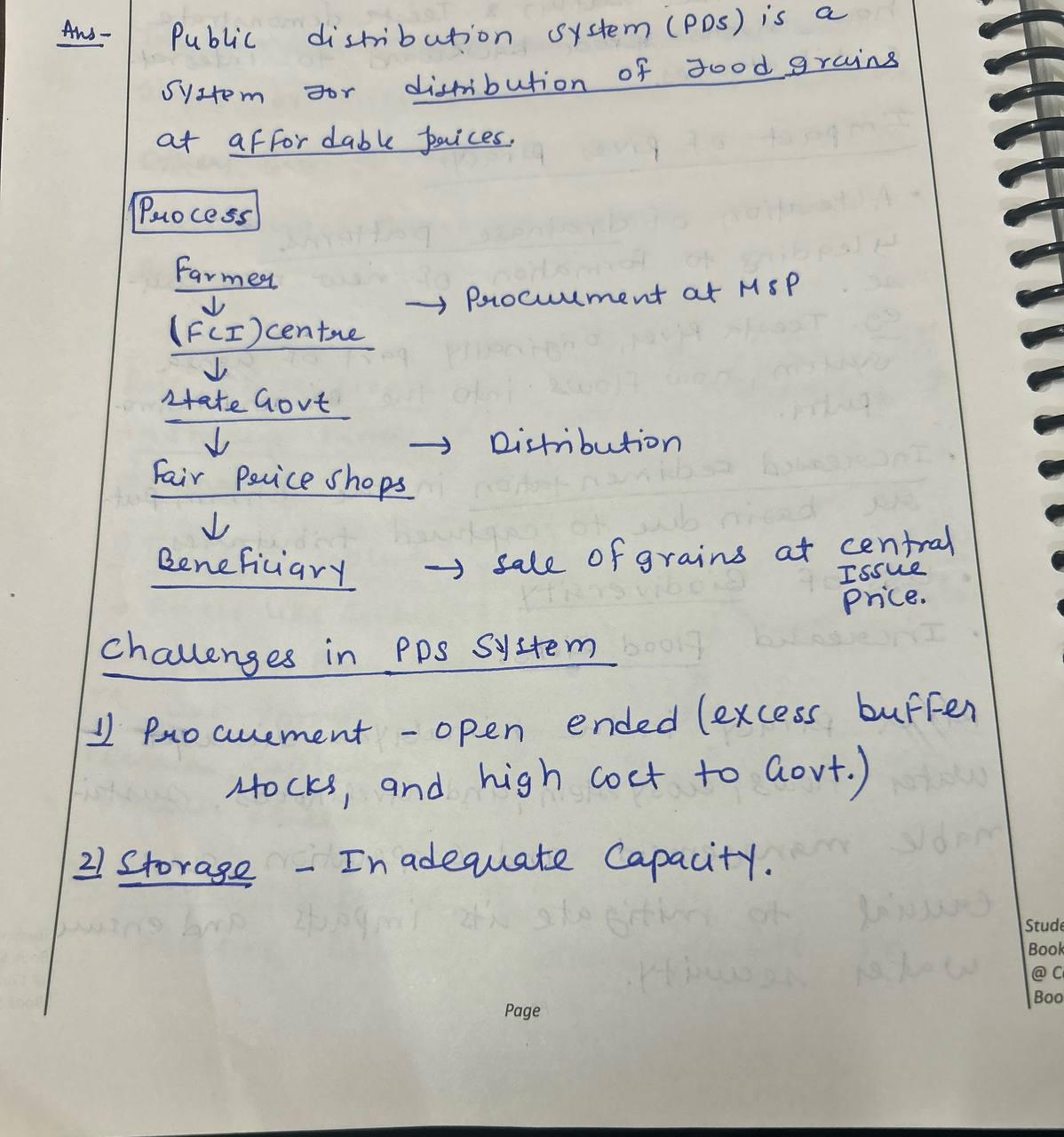
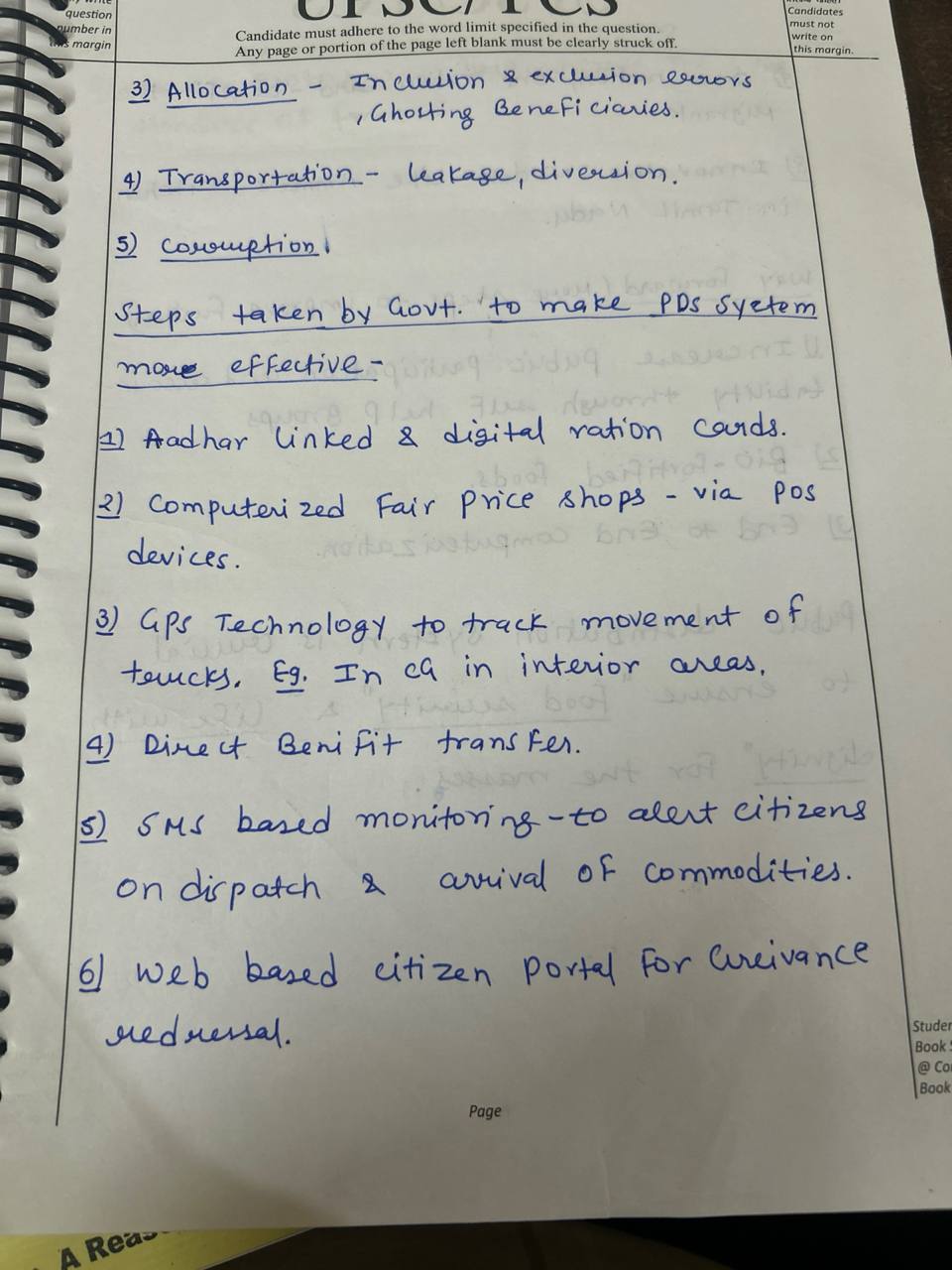

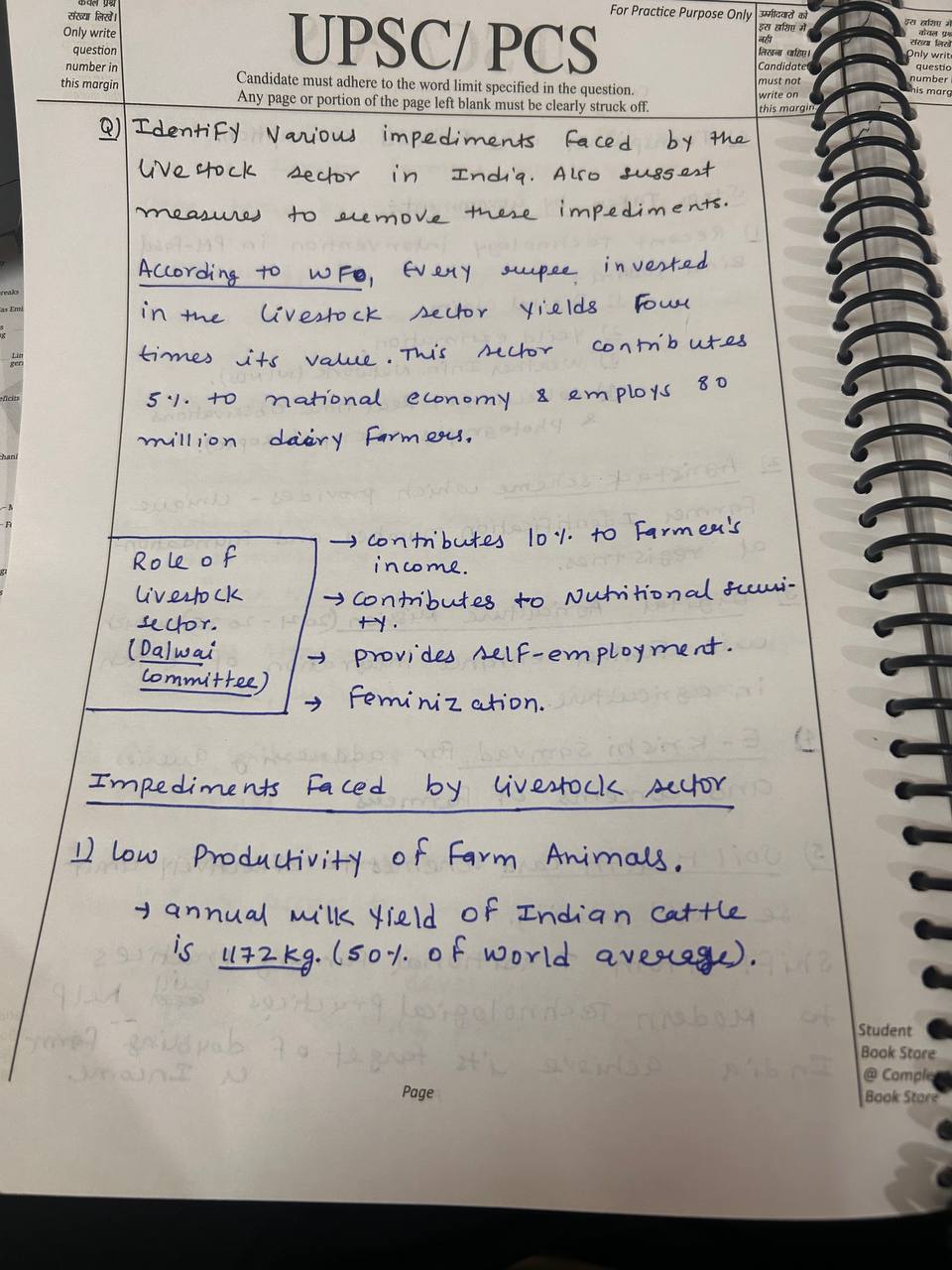
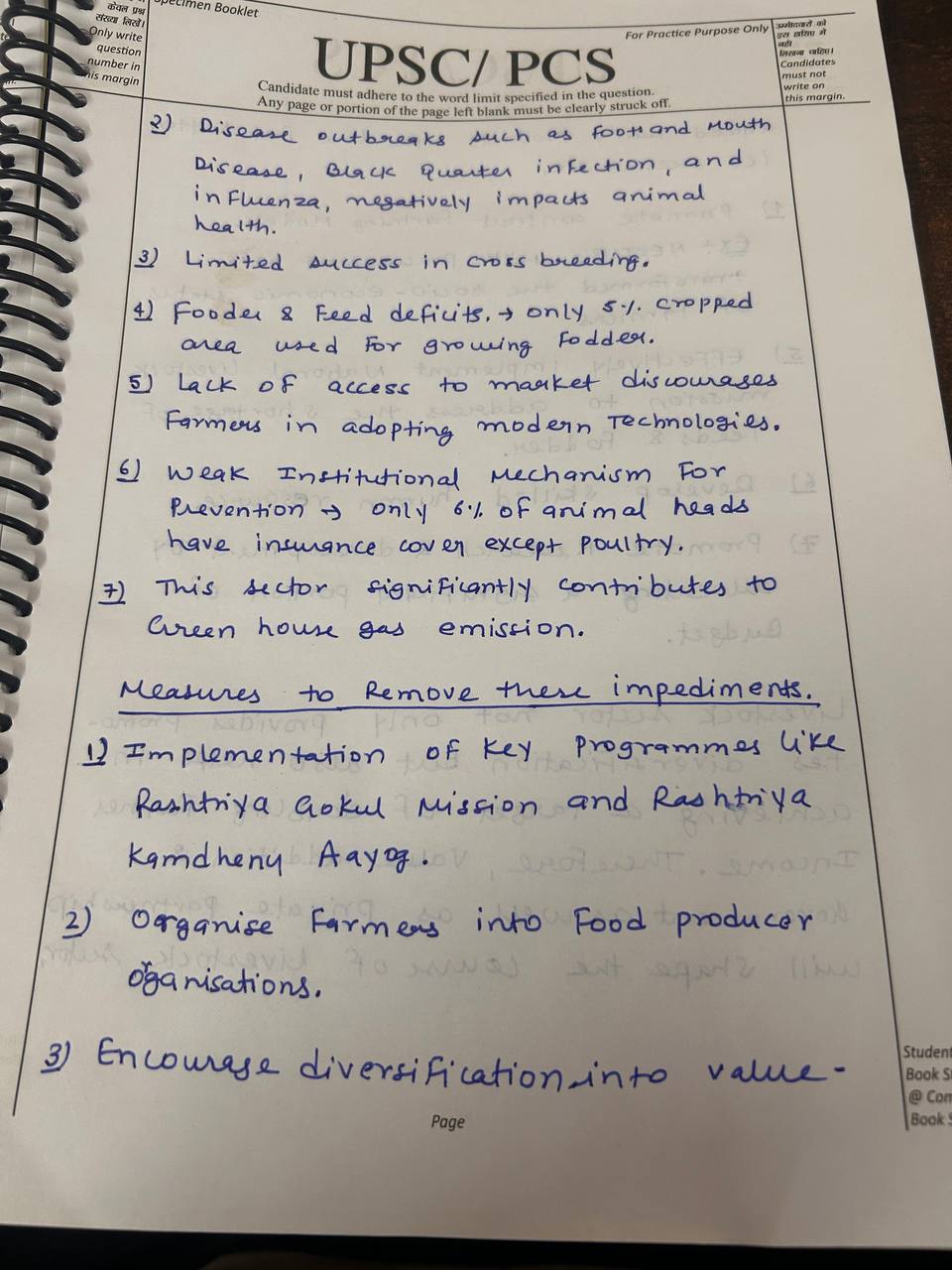
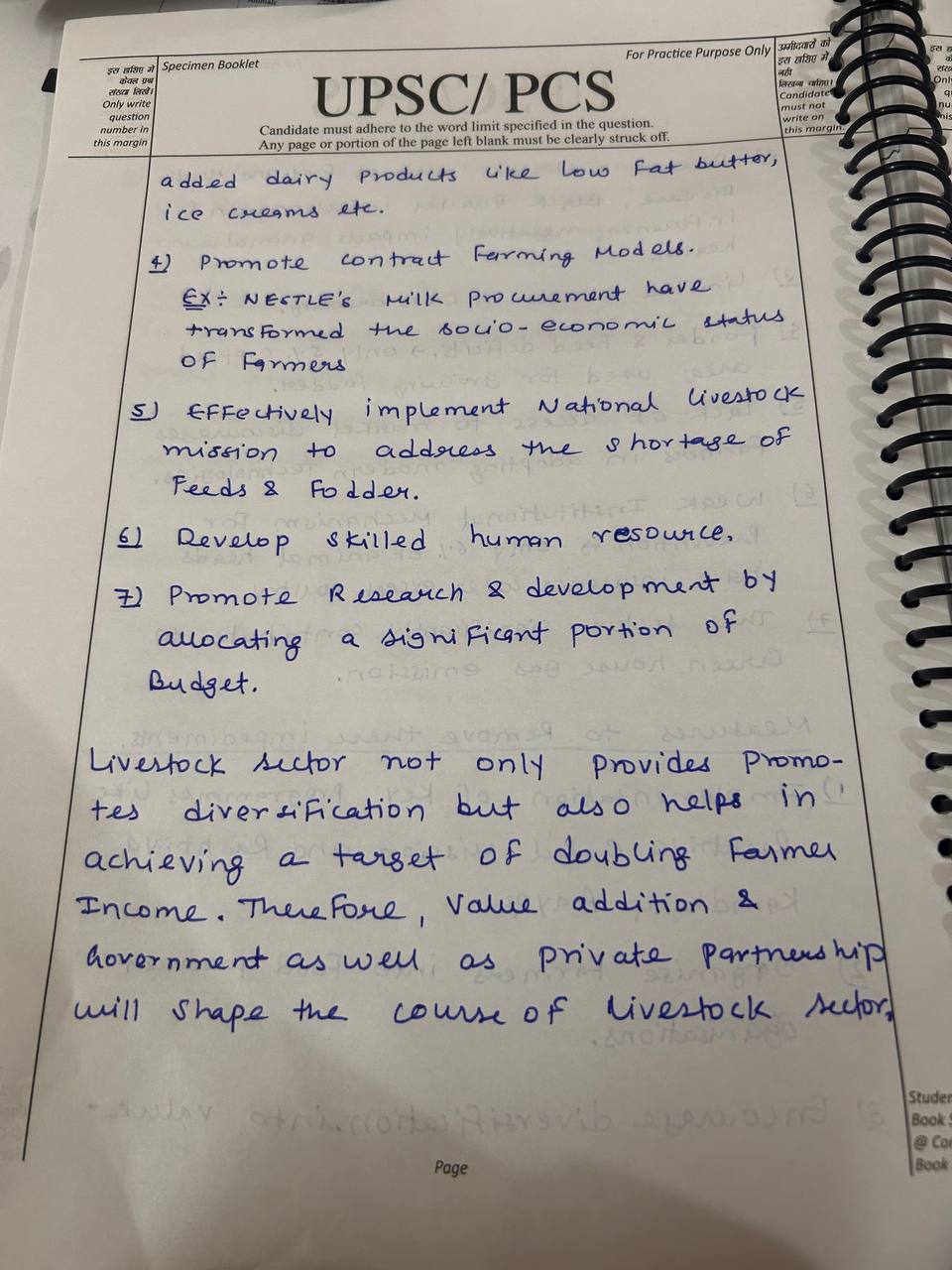
Model Answer Introduction Organic and natural farming are sustainable agricultural systems that prioritize ecological balance, biodiversity, and minimal use of synthetic inputs. These farming methods focus on nurturing soil health, promoting natural processes, and creating a balance between agricultRead more
Model Answer
Introduction
Organic and natural farming are sustainable agricultural systems that prioritize ecological balance, biodiversity, and minimal use of synthetic inputs. These farming methods focus on nurturing soil health, promoting natural processes, and creating a balance between agriculture and the environment. Both approaches are gaining recognition for their contribution to sustainable agricultural production.
Principles of Organic and Natural Farming:
1. Principles of Organic Farming:
2. Principles of Natural Farming
Contribution to Sustaining Agricultural Production
1. Preservation of Soil Health:
2. Reduced Environmental Impact:
3. Healthier Food:
4. Cost-Effectiveness:
5. Enhanced Resilience:
Limitations
- Transition Period: Shifting from conventional farming methods to organic or natural farming can be time-consuming and challenging. In some cases, such as Sri Lanka’s recent agricultural crisis, the transition can be risky if not carefully managed.
- Yield Variability: Natural farming methods may initially result in lower yields, especially during the transition period, before the soil and ecosystem stabilize.
- Labor-Intensive: Natural farming often requires more manual labor for tasks like mulching, composting, and pest management, which can increase the workload for farmers.
See less